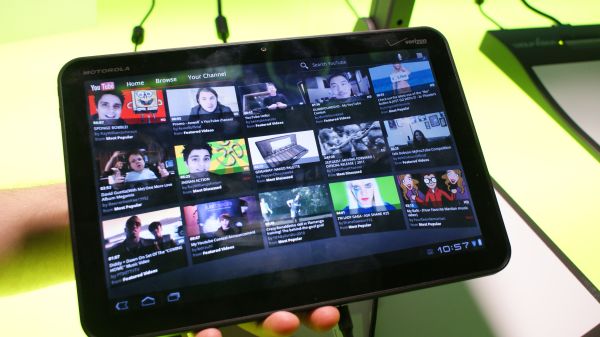Google Android 3.0 - Honeycomb Preview
by Saumitra Bhagwat on February 21, 2011 7:07 AM EST- Posted in
- Smartphones
- Honeycomb
- Android
- Mobile
Application Updates
Google has redesigned several of the core Android apps to take advantage of new UI elements like the Action Bar, hardware-accelerated graphics and of course the extra screen space. Apps like Music Player and YouTube have undergone some serious UI makeovers that really leverage the graphical prowess of the Renderscript graphics engine.

Just like on the iPad, Honeycomb brings a two pane UI to Email/Gmail. The app makes extensive use of the new Action Bar and “Fragments” framework to simplify workflows. Overall, the interface is clean and well organized.
Camera & Gallery

Froyo improved on the camera UI from Éclair (v2.1) by leaps and bounds; Honeycomb has taken it a step further and optimized it for two-handed operation on tablets. The new UI has a rotating dial-like interface that puts most important camera settings at your fingertips. The Gallery app has also been updated with a full-screen mode in addition to a thumbnail view of other pictures.
Browser
The browser on Honeycomb looks and feels a lot like Chrome. Its a serious upgrade to the stock Android browser found on earlier versions. Notable features include tabbed browsing, incognito mode, visual bookmarks, bookmark syncing and support for scalable vector graphics (SVG). SVG support was missing until now even though most mobile browsers like Opera Mini, Firefox Mobile and iOS Safari had supported it for a while. The Android browser has always shined performance-wise due to optimizations to JavaScript engine and the OS itself.
But a lot of the performance also depends on the underlying SoC. Google chose NVIDIA's Tegra 2 as the reference SoC for Honeycomb, so all of the initial Honecomb tablets will be based on NVIDIA's T20 SoC. For the latest benchmarks on Tegra 2 check out our Optimus 2X Review and Atrix 4G Preview.
Google Talk

The Google Talk app in Honeycomb (finally) adds support video conferencing. The interface is quite similar to the Gmail version of Google Talk. However, I’m more interested to see whether Honeycomb finally allows using multiple accounts with Google Talk. I was hoping Gingerbread would allow this, but alas I was proved wrong. The video conferencing interface is almost identical to how it’s handled in Gmail. Again, we’ll have more things to say as soon as we get our hands dirty with the Xoom.
Other Fixes

The keyboard has been slightly tweaked since Gingerbread and now includes a new “Tab” button. The keys have also been slightly modified for better placement and usability. The whole OS now supports multitouch gestures that are quite handy. Google has gone the extra mile to make sure that stock apps have a consistent and cohesive UI throughout. The OS now also adds a new UI for text selection, copy and paste that leverages the new Action Bar. Also included is an enhanced system-wide clipboard with drag and drop support that lets users copy, store and transfer content between parts of the OS and across applications. I’m sure there’ll be many minor tweaks and features scattered all over the OS, but we’ll have more on those in our detailed review soon enough.
Android Marketplace
The Marketplace app got a subtle facelift a few weeks ago, but was not updated with any new features in Gingerbread. The major announcement that came out of last week’s event was a web-based version of the Marketplace that you could browse from any computer. The website can also push purchased apps directly to your device within seconds. The other new feature is support for in-app purchases, which will be rolled out soon. Yet another example of the direction Google’s heading in with Android, tight integration with it’s own cloud services.
Developer Features
From a developer’s standpoint, Honeycomb features support for multiple cameras, multi-core processors, 2D/3D GPU acceleration across applications using the new Renderscript graphics engine, better compatibility across existing apps and so on. Also included is support for better multimedia and connectivity options like HTTP streaming, Media/Picture Transfer Protocol (MTP/PTP), a pluggable DRM framework to allow management of protected content regardless of the underlying DRM engine and API support for Bluetooth A2DP and HSP profiles. There are also some enhancements to the Enterprise feature set of the OS with policies for encrypted storage and password management.
Under The Hood Changes
Perhaps the biggest change in Honeycomb is that the Dalvik VM environment is now multi-core aware. This means the OS can now leverage the processing power and potential power savings of multi-core SoCs to speed things up and offer enhanced battery life. In fact, even single threaded apps can see speed improvements in Honeycomb. While running in a dual-core environment, the OS automatically lets the bytecode run on one core and the Dalvik garbage collector run on the other. Apps specifically written to support symmetric multiprocessing will see even larger performance gains. With companies like ARM (Cortex A15) and Qualcomm (Snapdragon “Krait”) already announcing their next-gen dual/quad-core SoC architectures, it will be exciting to see what kind of mobile performance we have in store for the future!











65 Comments
View All Comments
jrs77 - Monday, February 21, 2011 - link
I'm the typical nerd using a plethora of different devices and software. My desktop is running Windows 7, my HTPC is running Ubuntu+XBMC, my MacBookPro is MacOS X and my Nokia is running Symbian.If I would use all Apple products there, then my experience would be consistent throughout all the devices. Hardware and software being developed to work flawlessly etc.
If I'm going to use Android x86 for my PCs and Android 2.3 for my phone and Android 3.0 for my tablet etc, then it simply wouldn't be anymore consistent then the plethora of different OS and devices I'm using currently, so it actually doesn't offer anything I'd desire.
If the manufacturers now start to tweak Android for their devices then the devices get even more differentiated then what I allready have today.
Imho, the Android OS should be allways the same, so that I can switch from one Android-tablet to another and then to my smartphone without problems because of a different UI etc and the hardware for all those devices should be the way, that the experience is aswell the same, e.g. apps loading as fast as on the other devices etc.
Apple achieves this consistency and it's the reason for their success.
bplewis24 - Monday, February 21, 2011 - link
Then go with Apple, if that's what you want. You may not be able to conceive the concept that other people may not want what you want, but that doesn't mean it's not possible.And if you really believe that is the reason for Apple's success, I feel sorry for you.
Brandon
strikeback03 - Tuesday, February 22, 2011 - link
I disagree, IMO there need to be substantial differences in the interface design based on the usage model. An interface that works well on a <4" touchscreen is likely not the best option for a desktop using a 24" screen with keyboard and mouse.bplewis24 - Monday, February 21, 2011 - link
All what devices? Apple makes one device per generational year. This "fragmentation" argument is bunk.Would you be happier if blu-ray manufacturers only sold one type of blu-ray machine per year, or do you appreciate the fact that they "fragment" themselves with several models of players at different price points, hardware features and functionality each release cycle?
Yet when phone manufacturers offer cheaper phones with cheaper hardware and lesser features, it's "fragmentation" that is going to kill off the brand? Hardly. The only thing it does it ruin brand-awareness for mainstream consumers who know nothing about technology and believe that an OS manufacturer is the same as a hardware manufacturer.
These people thus believe an Android 1.6 device made by Archos is representative of a Android 3.0 device made by HTC with an Nvidia T20 SoC. For those people, maybe Apple is best, as with their ecosystem it's very easy to live in that sheltered bubble.
Brandon
spambonk - Tuesday, February 22, 2011 - link
You overlook that the whole point is to be different on different devices. Android are for people who can make up their own mind, and not have others do it for them.TareX - Monday, February 21, 2011 - link
While I think it's "nice" Google is waiting till the end of May to announce Ice Cream, I think there are two features of Honeycomb Android needs to get pronto:1) UI HW Acceleration
2) Multi-language support in the browser
I mean I can't believe in 2011, Android's browser can't recognize Arabic text, for example.
TareX - Monday, February 21, 2011 - link
How smooth did Flash run in Honeycomb's browser? I realize it hasn't been released for Honeycomb yet (ver 10.2) but you can download it from the market. Doe sit make use of Tegra 2's GPU acceleration?Jumangi - Monday, February 21, 2011 - link
Apparently the Xoom won't ship with Flash support....but get it 'sometime in the Spring'.Pjotr - Monday, February 21, 2011 - link
"This is a huge addition as it Again, the UI is extremely clean and should work well on tablets."?Saumitra - Monday, February 21, 2011 - link
Fixed!Cheers,
Saumitra